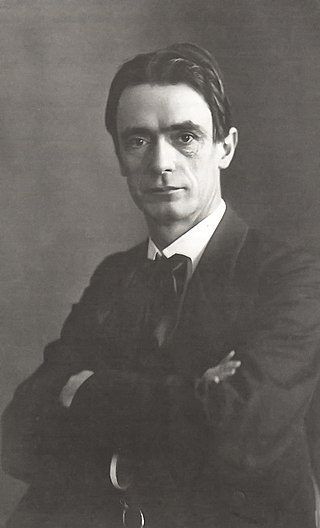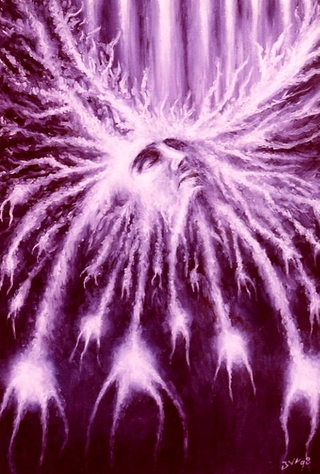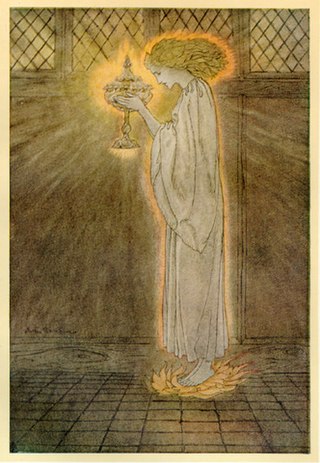Related Research Articles

Charles Webster Leadbeater was a member of the Theosophical Society, Co-Freemasonry, an author on occult subjects, and the co-initiator, with J. I. Wedgwood, of the Liberal Catholic Church.

In the religion of Theosophy and the spiritual movement called Anthroposophy, the Akashic records are a compendium of all universal events, thoughts, words, emotions and intent ever to have occurred in the past, present, or future in terms of all entities and life forms, not just human. They are believed by theosophists to be encoded in a non-physical plane of existence known as the mental plane. Because it is believed that the records are encoded vibrationally into the inherent fabric of space, some have likened the mechanism as similar to how holograms are created. There is currently no scientific evidence for the existence of the Akashic records, and rigorous scientific research in this field has seen little traction.

The astral body is a subtle body posited by many philosophers, intermediate between the intelligent soul and the mental body, composed of a subtle material. In many recensions the concept ultimately derives from the philosophy of Plato though the same or similar ideas have existed all over the world well before Plato's time: it is related to an astral plane, which consists of the planetary heavens of astrology. The term was adopted by nineteenth-century Theosophists and neo-Rosicrucians.

Ascended masters in the Ascended Master Teachings of a number of movements in the theosophical tradition are held to be spiritually enlightened beings who in past incarnations were ordinary humans, but who have undergone a series of spiritual transformations originally called initiations.

The astral plane, also called the astral realm or the astral world, is a plane of existence postulated by classical, medieval, oriental, and esoteric philosophies and mystery religions. It is the world of the celestial spheres, crossed by the soul in its astral body on the way to being born and after death, and is generally believed to be populated by angels, spirits or other immaterial beings. In the late 19th and early 20th century the term was popularised by Theosophy and neo-Rosicrucianism.
In esoteric cosmology, a plane is conceived as a subtle state, level, or region of reality, each plane corresponding to some type, kind, or category of being.

Alfred Percy Sinnett was an English author and theosophist.

Root races are stages in human evolution in the esoteric cosmology of theosophist Helena Petrovna Blavatsky, as described in her book The Secret Doctrine (1888). These races existed mainly on now-lost continents. Blavatsky's model was developed by later theosophists, most notably William Scott-Elliot in The Story of Atlantis (1896) and The Lost Lemuria (1904). Annie Besant further developed the model in Man: Whence, How and Whither (1913). Both Besant and Scott-Elliot relied on information from Charles Webster Leadbeater obtained by "astral clairvoyance". Further elaboration was provided by Rudolf Steiner in Atlantis and Lemuria (1904). Rudolf Steiner, and subsequent theosophist authors, have called the time periods associated with these races Epochs.
A Treatise on White Magic is a book by Alice Bailey. It is considered to be among the most important by students of her writings, as it is less abstract than most, and deals with many important subjects of her works in an introductory, even programmatic fashion. It was first published in 1934 with the subtitle 'The Way of the Disciple'. She promulgated White Magic as a discipline to serve humanity.

In neo-Theosophy, the etheric body, ether-body, or æther body is the subtle body propounded in esoteric philosophies as the first or lowest layer in the human energy field or aura. The etheric body is said to be in immediate contact with the physical body and to sustain it and connect it with "higher" bodies. It is also said to consist of a finer substance, more pure and composed of smaller particles, than the ordinary matter of the physical plane.
The etheric plane is a term introduced into Theosophy by Charles Webster Leadbeater and Annie Besant to represent the subtle part of the lower plane of existence. It represents the fourth [higher] subplane of the physical plane, the lower three being the states of solid, liquid, and gaseous matter. The idea was later used by authors such as Alice Bailey, Rudolf Steiner, Walter John Kilner and others.

A round, in the esoteric cosmology of Theosophy, Anthroposophy and Rosicrucianism, is a cosmic cycle or sequence by which an evolving reincarnating being passes through the various stages of existence as the Earth, the Solar System or the Cosmos comes into and passes out of manifestation.
The Summerland is the name given by Theosophists, Wiccans and other contemporary pagan religions to their conceptualization of an afterlife.
Master Jesus is the theosophical concept of Jesus in theosophy and the Ascended Master Teachings.

In Theosophy, Maitreya or Lord Maitreya is an advanced spiritual entity and high-ranking member of a reputed hidden spiritual hierarchy, the Masters of the Ancient Wisdom. According to Theosophical doctrine, one of the hierarchy's functions is to oversee the evolution of humankind; in concert with this function Maitreya is said to hold the "Office of the World Teacher". Theosophical texts posit that the purpose of this Office is to facilitate the transfer of knowledge about the true constitution and workings of Existence to humankind. Humanity is thereby assisted on its presumed cyclical, but ever progressive, evolutionary path. Reputedly, one way the knowledge transfer is accomplished is by Maitreya occasionally manifesting or incarnating in the physical realm; the manifested entity then assumes the role of World Teacher of Humankind.
In the teachings of Theosophy, the Manu is one of the most important beings at the highest levels of Initiation of the Masters of the Ancient Wisdom, along with Sanat Kumara, Gautama Buddha, Maitreya, the Maha Chohan, and Djwal Khul. According to Theosophy, each root race has its own Manu which physically incarnates in an advanced body of an individual of the old root race and physically progenerates with a suitable female partner the first individuals of the new root race. The Theosophical concept of the Manu is derived from the concept in Hinduism that the Manu was the being who was the progenitor of the human race.

Man: Whence, How and Whither, A Record of Clairvoyant Investigation, published in 1913, is a theosophical book compiled by the second president of the Theosophical Society (TS) - Adyar, Annie Besant, and by a TS member, Charles W. Leadbeater. The book is a study on early times on planetary chains, beginnings of early root races, early civilizations and empires, and past lives of men.

Theosophy is a religion established in the United States during the late 19th century. It was founded primarily by the Russian Helena Blavatsky and draws its teachings predominantly from Blavatsky's writings. Categorized by scholars of religion as both a new religious movement and as part of the occultist stream of Western esotericism, it draws upon both older European philosophies such as Neoplatonism and Indian originated religions such as Hinduism and Buddhism.

Esoteric Buddhism is a book originally published in 1883 in London; it was compiled by a member of the Theosophical Society, A. P. Sinnett. It was one of the first books written for the purpose of explaining theosophy to the general public, and was "made up of the author's correspondence with an Indian mystic." This is the most significant theosophical work of the author. According to Goodrick-Clarke, it "disseminated the basic teachings of Theosophy in its new Asian cast."

Modern Theosophy has had considerable influence on the work of visual artists, particularly painters. Artists such as Wassily Kandinsky, Piet Mondrian, and Luigi Russolo chose Theosophy as the main ideological and philosophical basis of their work.
References
- ↑ H.P. Blavatsky, The Theosophical Glossary. Theosophical Publishing Society, 1892, page 98
- ↑ H.P. Blavatsky, The Secret Doctrine. Theosophical Publishing Society, 1888, page 39
- ↑ Leadbeater, C.W. A Textbook of Theosophy 1912
- ↑ Leadbeater, C.W. The Masters and the Path 1926,
- ↑ "Various Levels of the Afterlife in Theosophy:". Archived from the original on 2011-07-22. Retrieved 2011-07-13.
- ↑ Steiner, Rudolf. "Jeshu ben Pandira Who Prepared the Way for an Understanding of the Christ Impulse (part I)". Rudolf Steiner Archive. The first of two lectures delivered at Leipzig on November 4 and 5, 1911. GA# 130